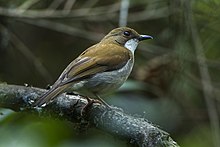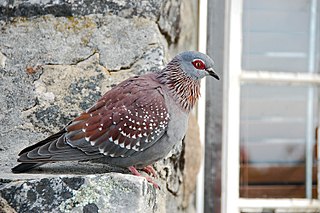
The speckled pigeon, also African rock pigeon or Guinea pigeon, is a pigeon that is a resident breeding bird in much of Africa south of the Sahara. It is a common and widespread species in open habitats over much of its range, although there are sizable gaps in its distribution. It is sometimes referred to as the Guinea pigeon due to its similar coloring to some species of guineafowl.

The Narina trogon is a largely green and red, medium-sized, bird of the family Trogonidae. It is native to forests and woodlands of the Afrotropics. Though it is the most widespread and catholic in habitat choice of the three Apaloderma species, their numbers are locally depleted due to deforestation. Some populations are sedentary while others undertake regular movements. The species name commemorates Narina, mistress of French ornithologist François Levaillant, whose name he derived from a Khoikhoi word for "flower", as her given name was difficult to pronounce.

Mulanje Mountain Forest Reserve is a nature reserve founded in 1927 in Malawi. The reserve covers 56,317 hectares. It is operated by the Mulanje Mountain Conservation Trust. The reserve was designated a biosphere reserve by UNESCO in 2000.
Enteromius choloensis, or the silver barb, is a species of freshwater fish in the family Cyprinidae.

Fischer's sparrow-lark or Fischer's finch-lark is a species of passerine bird in the family Alaudidae. It is found from central Kenya to eastern Zambia, Malawi and north-western Mozambique. Its natural habitat is subtropical or tropical dry lowland grassland.
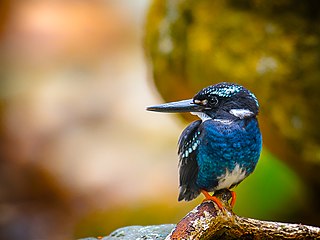
The southern silvery kingfisher is a species of bird in the family Alcedinidae that is endemic to the Philippines found in Mindanao and Basilan. This species and the northern silvery kingfisher, found in the Visayas, were formerly considered conspecific and called the silvery kingfisher.Its natural habitats are tropical moist lowland forests, streams and rivers.. It is threatened by habitat loss.

The white-tailed alethe is a species of bird in the Old World flycatcher family Muscicapidae. It is found in western Africa from Senegal to Togo. Its natural habitat is subtropical or tropical moist lowland forests.

The white-chested alethe is a species of bird in the family Muscicapidae. It is found in Malawi, Mozambique, Tanzania, and Zambia.
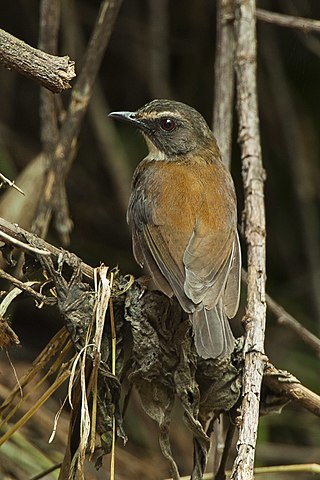
The brown-chested alethe is a species of bird in the Old World flycatcher family Muscicapidae. It has a discontinuous range of presence across the African tropical rainforest.
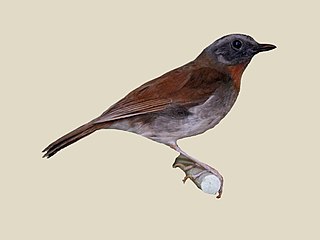
The red-throated alethe is a species of bird in the family Muscicapidae. It is native to the Albertine Rift montane forests. Its natural habitat is subtropical or tropical moist montane forests.

The white-winged apalis is a species of bird in the family Cisticolidae. It is found in Kenya, Malawi, Mozambique, and Tanzania. Its natural habitats are subtropical or tropical moist lowland forest and subtropical or tropical moist montane forest. It is threatened by habitat loss.

The Visayan broadbill is a species of bird in the family Eurylaimidae where it was previously conspecific with the wattled broadbill. It is endemic to the islands of Samar, Leyte and Bohol in the central Philippines. Its natural habitat is tropical moist lowland forests. It is threatened by habitat loss.

The wattled broadbill or Mindanao broadbill is a species of bird in the family Eurylaimidae where it was previously conspecific to the Visayan broadbill. It It is endemic to the islands of Mindanao, Basilan, Dinagat and Siargao in the Philippines. It is one of the most striking birds in the country with its sky-blue wattle and bill and yellow wing patch. Its natural habitats are tropical moist lowland forest, tropical mangrove forest, and tropical moist shrubland. It is threatened by habitat loss.

The Angola swallow is a species of swallow that is native to the Afrotropics.

The spotted ground thrush is a species of bird in the family Turdidae. It is found in the Democratic Republic of the Congo, Kenya, Malawi, South Africa, Sudan, Tanzania, and possibly Mozambique.

The Andaman woodpecker is a species of bird in the woodpecker family Picidae. It is endemic to the Andaman Islands in India. Its natural habitat is tropical moist lowland forests. It is threatened by habitat loss.
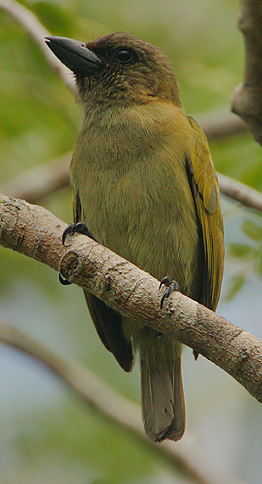
The green barbet is a species of bird in the Lybiidae family. It is found in Kenya, Tanzania, Malawi, Mozambique and South Africa. It occurs in forests from sea level to 1,800 metres (5,900 ft). Its isolated populations are vulnerable to forest clearing.

The fire-crested alethe is a species of bird in the Old World flycatcher family Muscicapidae. It is found in central Africa, from Nigeria to Uganda. Its natural habitat is subtropical or tropical moist lowland forests.

Mount Namuli is the second highest mountain in Mozambique and the highest in the Province of Zambezia. It is 2,420 m (7,940 ft) high and was measured, surveyed and described in 1886 by Henry Edward O'Neill, the British consul in Mozambique. The Namuli massif consists of a level plateau with the granite dome of Mount Namuli above. The area was historically clad in tropical rainforest and is an important biodiversity hotspot with many endemic species of animals and plants. The lower slopes are now mainly used for the cultivation of tea and the middle slopes for other agricultural purposes, with indigenous forest now mostly restricted to the higher parts and corridors along water courses.

Chamaetylas is a genus of small, mainly insectivorous birds in the Old World flycatcher family Muscicapidae that are native to sub-Saharan Africa.
